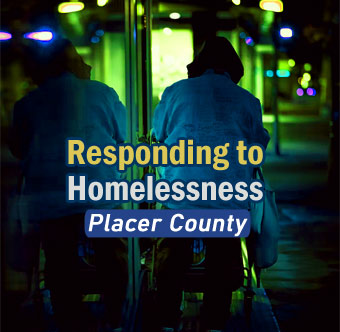Potential strategies to respond to homelessness
Roseville, Calif.- A variety of potential strategies are beginning to emerge from Phase I of a regional effort to develop options that address homelessness in the mid and south Placer region.
Two strategy response groups have been meeting since Sept. 2021 to review existing conditions and spotlight emerging priorities under the facilitation of MIG, Inc., a consulting firm and recognized leader in community social policy and planning.
One of the strategy response groups is an ad hoc committee made up of two elected leaders each from the county and its five cities and one town. That committee is supported by a cross-jurisdictional steering group tasked with providing process oversight.
Preliminarily, the consultant has compiled a list of potential strategies for further exploration and included them in the Placer Homelessness Response Emerging Strategies Phase 1 Report, which has been released for public review.
Placer Homelessness Response
Presentations
MIG, Inc. will make informational presentations to town and city councils in the mid and south Placer region in the weeks ahead, starting with the Roseville City Council’s upcoming meeting on Wednesday, March 16. MIG will share preliminary findings and take questions and comments from council members and the public. Additional dates and times for presentations at the Lincoln, Rocklin, Auburn, and Loomis meetings will be shared as they are confirmed.
Potential Strategies
The report identifies a framework and over a dozen potential strategies to mitigate homelessness impacts, including exploring the need for an emergency shelter in south Placer, expanding partnerships between law enforcement and social services for outreach and response, implementing regionally compatible ordinances and law enforcement practices, exploring the potential for a sobering center with support services and evaluating the possibility of expanding interim and permanent supportive housing.
The strategies listed in the report represent a base of ideas for additional analysis and testing, implementation considerations, and community and stakeholder input. They do not represent an endorsement of the group of elected officials who took part in this process.
In the next few months, many of the stakeholders who have been involved will be invited to continue their participation, as strategies are translated into specific initiatives. In addition, there will be a broader community dialogue, including town-hall-style conversations in both south and mid Placer and a statistically valid survey of residents.
Limitations of government options
While Placer experiences the lowest rate of homelessness in northern California, the fourth lowest rate of homelessness in the state overall, and the lowest rate of unsheltered homeless in the state – even as Placer’s overall population has grown significantly – homelessness and blight have become more visible. Several factors add complexity and limitations to the options government has to address homelessness.
These include:
- Recent court rulings, including Martin v. Boise, which prohibit the imposition of criminal penalties on unsheltered homeless persons for sitting, sleeping or lying on public property unless there is viable shelter space available.
- Health restrictions and effects of a global pandemic.
- The fact that some unhoused people who interface with law enforcement and service providers decline services designed to assist them and help them secure shelter. This regularly increases the expenses for costly resources in the health care and criminal justice systems.
Coordinated effort
Given these challenges, there is increased recognition that addressing homelessness requires a coordinated and steady effort by multiple partners from each jurisdiction, community-based organizations, the local business and faith communities, service providers, county departments, and the Homeless Resources Council of the Sierras, the nonprofit public benefit corporation that serves as the administrative entity for the Placer County and Nevada County homeless continuums of care.
It also requires an understanding among residents and business owners of the legal parameters in order to explore and suggest viable options. The coordinated response process stemmed from this recognition and aims to expedite progress and address deep-rooted challenges.
As Phase 1 of this process draws to a close, Phase 2 will focus on taking the strategies and conducting additional analysis, applying implementation considerations, and gathering community and stakeholder input.
related: Homeless Challenge
- Placer County regional homelessness planning efforts to transition under local Continuum of Care
- Placer County pragmatism pays dividends on homelessness
- Placer County homelessness 2023
- Placer County mobile temporary shelter for unhoused in North Auburn
- California cities to receive grants to clean up Homeless Encampments
- Campus of Hope Homeless Shelter near Rocklin envisioned by The Gathering Inn
- Placer hires firm to assist in working with homeless population
- Many Homeless Have Mental Illness
- Homeless response strategies
- Homeless Shelter Zoning Options Expanded
- Roseville hotel to be converted into into permanent housing for homeless
Other Sources
(21+ years strong)
Welcome to the brighter side!
Get in front of local customers! 24/7 (365)























